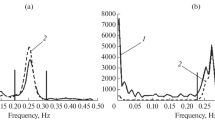Abstract
Two algorithms, based on coherency and correlation functions, are proposed for estimating the signal-to-noise ratio of physiological signals including the effect of flicker noise. New sampling techniques based on converting a single continuous signal into two time series that satisfy the requirements of the algorithms are proposed. The algorithms are applied to a computer-generated signal and noise composite of known SNR, as well as to quasiperiodic left ventricular pressure (LVP) waveforms transduced from ten patients. Both coherency and correlation methods were used to estimate the known SNR of the computer-generated compsite, signal and noise to within ±5 per cent, for SNR values between 10 and 30 dB. When applied to LVP waveforms, the two methods gave SNR values which were almost identical. Flicker noise associated with the LVP waveforms was computed to be 14 dB higher than the white noise. It is concluded that flicker, or 1/f noise, which has been heretofore ignored in SNR calculations of pressure and flow signals, must now be included.
Similar content being viewed by others
References
Beduchamp, K. andYuen, C. (1979)Digital methods for signal analysis. George Allen & Unwin, London.
Benignus, V. A. (1969a) Estimation of the coherence spectrum and its confidence interval using the fast Fourier transform.IEEE Trans.,AU-17, 145–150.
Benignus, V. A. (1969b) Estimation of coherence, spectrum of non-Gaussian time series populations.,AU-17, 198–201.
Carter, G. C., Knapp, C. H. andNuttall, A. H. (1973) Estimation of the magnitude-squared coherence function via overlapped fast Fourier transform processing.,AU-21, 337–344.
Carter, G. C. andKnapp, C. H. (1975) Coherence and its estimation via the partitioned modified chirp-Z transform.,ASSP-23, 257–264.
Charayaphan, C. (1987) Selection, implementation, and testing of an efficient algorithm for real-time computation of signal-to-noise ratio of physiological signals. Master Thesis, Technical University of Nova Scotia, 14–16.
De Boer, L. W. V., Nosta, J. J., Kloner, R. A. andBrunwald, E. (1982) Studies of Amiodarone during experimental myocardial infarction; beneficial effects on hemodynamics and infarct size.Circ.,65, 508–512.
Fay, J. W. (1980) Comfidence bounds for signal-to-noise ratios from magnitude-squared coherence estimates.IEEE Trans.,ASSP-28, 758–760.
Fink, D. G. andChristiansen, D. (1982)Electronics Engineers' Handbook, 2nd edn. McGraw-Hill, New York.
Kornreich, F., Rautaharju, P. M., Warren, J. W., Horacek, B. M. andDramaix, M. (1985) Effective extraction of diagnostic ECG waveform information using orthonormal basic functions derived from body surface potential maps.J. Electrocardiol.,18, 341–350.
Kornreich, F., Montague, J. J., Rautaharju, P. M., Block, P., Warren, J. W. andHoracek, B. M. (1986) Identification of best electrocardiographic leads for diagnosing anterior and inferior myocardial infarction by statistical analysis of body surface potential maps.Am. J. Cardiol.,58, 863–871.
Mirsky, I., Dharjoy, N. andSandler, H. (1974)Cardiac mechanics: physiological, clinical and mathematical considerations. Wiley, New York, 102–107.
Oppenheim, A. V. andSchaeer, R. W. (1975)Digital signal processing. Prentice-Hall, Inc., New York.
Scannell, E. H. andCarter, G. C. (1975) Confidence bounds for magnitude-squared coherence estimates.IEEE Trans.,ASSP-26, 475–477.
Soderquist, D. (1979) Minimization of noise in operational amplifier applications. InPMI Data Book.PMI, 15/43-15/51.
Stoisiek, M. andWolf, D. (1980) Origin of 1/f noise in bipolar transistors.IEEE Trans.,ED-27, 1753–1757.
Suh, C. H. (1981) A new theory of g-r and 1/f nois.,ED-28, 1555–1557.
Author information
Authors and Affiliations
Rights and permissions
About this article
Cite this article
Charayaphan, C., Marble, A.E., Nugent, S.T. et al. Estimation of signal-to-noise ratio of a quasiperiodic cardiovascular signal using coherency and correlation techniques. Med. Biol. Eng. Comput. 27, 572–579 (1989). https://doi.org/10.1007/BF02441638
Received:
Accepted:
Issue Date:
DOI: https://doi.org/10.1007/BF02441638




